"Setup did not find any hard disk drives installed in your computer" Welcome to Microsoft's Windows XP Professional "Setup did not find hard drive" fresh install step by step, this guide is to help you through a windows install when you can't find the hard drive, or I doesn't seem to be available . This will give you an idea on how to do this when and if the time arises for you to either reinstall the operating system, install for the first time or upgrade your present operating system. This install guide is fully graphical and will take you through each step of the installation. The error you will usually get is pictured below, but remember windows will pick up card readers, and other hard drives also. 
The first thing you will have to do is find out the manufacturer of your motherboard, and also the type of drive you are using. SATA (Serial ATA) Hard Drive
SATA Connectors on hard drive | SATA data cable |  | 
|
IDE Cable
| IDE (PATA) Connectors on Hard Drive | IDE (PATA) data cable |  |  |
Once you have determined the type of hard drive you have go to the motherboard/computer manufacturers website and download the SATA or PATA drivers for that board. Make sure if the files are compressed that you extract them to your floppy disks. Now copy the extracted files, (Or downloaded file) onto a blank floppy disk. If you are using a raid array then you will also need the motherboards raid driver.
Your Windows XP Professional CD Windows XP COA, or serial number. Your computer Plugged into Mains Power A Computer, with the usual accessories (Mouse, monitor, keyboard etc) CD-ROM/DVD Drive.
To start this Windows install. First check that the first boot device in your system BIOS is set to the CD-ROM Drive. ( To find out how to access the BIOS please refer to your motherboard manual or the manufacturer of your Computer. (The system bios can usually be entered on boot, usually by pressing the F1, F2, F8, F10 or DEL key. Make sure you save the settings before exiting)) If you are unsure or don't want to enter the BIOS then just test the computer by putting the CD-ROM in the drive and reboot your computer. This is the recommended way to install windows.
To begin install insert your Windows XP Professional CD, or first boot disk and reboot you computer. You may get prompted to press a key to boot of CD. Click any key on keyboard to boot. 
Setup will start inspecting your computer hardware and configuration. 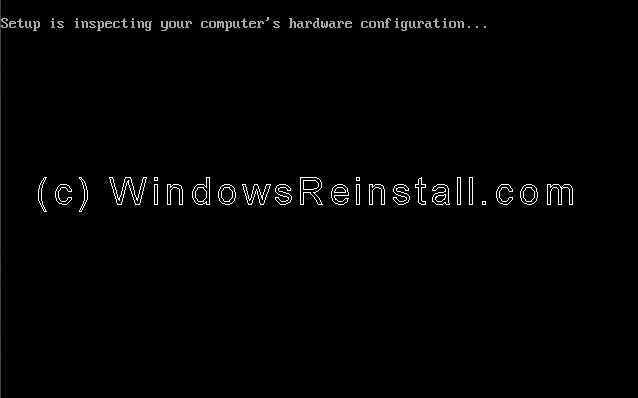
As soon as the next screen appears press the "F6" key. This is the first blue screen to appear and you will see the prompt at bottom that says "Press F6 if you need to install a third party SCSI or Raid driver". You only have a few seconds to react to this prompt. If you find the F6 key doesn't work then check that your keyboard doesn't have an F-Lock key, this may need pressed to activate the keys. Be warned though it will be several minutes before you know if you pressed the key correctly. 
If you have pressed the "F6" key on time then the following screen will eventually appear. Press "S" to load in the drivers you downloaded. 
You will now be prompted for the floppy disk you created earlier, put it in the drive and press "ENTER" 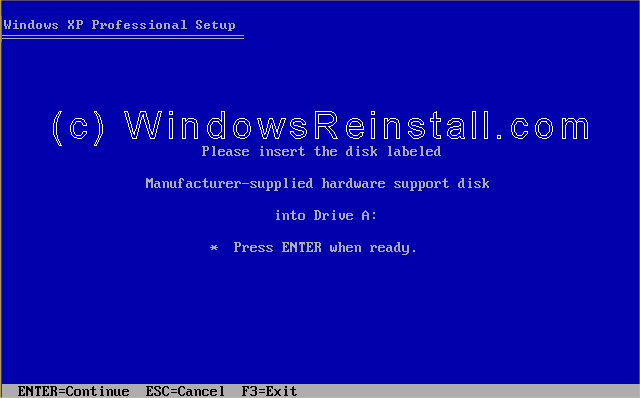
Setup will now you give you a choice of files that it found on the floppy drive. We are installing a SATA drive, so we select the "SATA-RAID Required 1", use arrow keys to select then press "ENTER" to load. 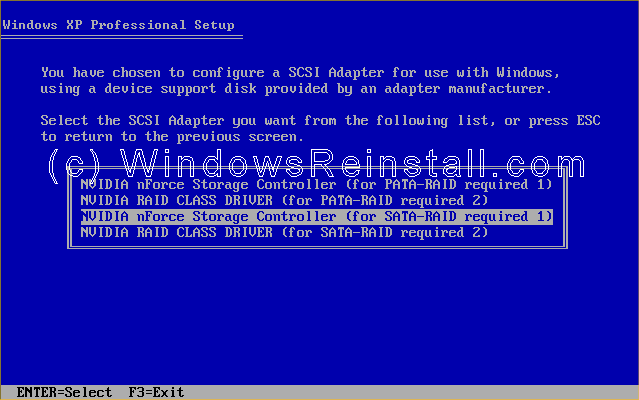
This will return you to the main screen. In our case we need to load two drivers of the disk, so Press "S" again to load in another file. 
Once again the floppy prompt, as floppy disk is still in driver press "ENTER" 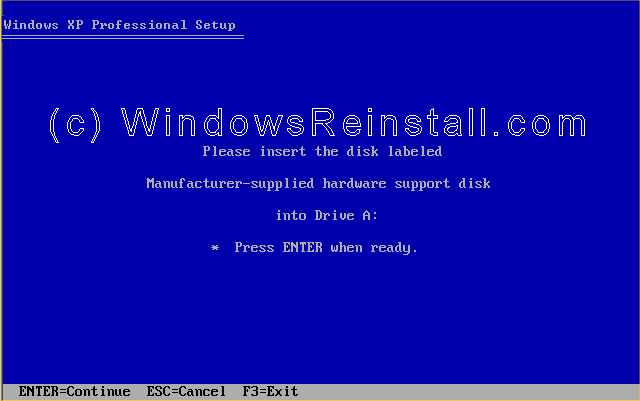
We now select the option for "SATA-RAID Required 2", use arrow keys to select then press "ENTER" to load. 
Once again you are returned to the main screen, as you can see the two files are loaded, press "ENTER" to continue to the Windows Install. 

Now you have to select where to install XP. Press "ENTER" to confirm the partition you want to install into. 
Now you need to format the hard drive, NTFS is recommended, but you can also use FAT32. Make your decision using the arrow keys and press enter. 
The hard drive will now format. 
and then setup will begin to copy files. 
Setup now initialises the Windows XP configuration. 
It is now time to restart Windows XP, press "ENTER" to speed up process, otherwise Windows will do it itself in 15 seconds. 
Boot will recognize that the XP CD is in the drive, DO NOT press any keys, let setup bypass the CD boot. 
Windows is now booting. 
The install process continues. 
Now your regional and language options. Your mouse should now be active, so click on "CUSTOMIZE". 
Now select your Standards and Formats, plus your location, then click "OK". 
Now click on "DETAILS". 
Next select your default language, click "OK" when done. 
Now that you have made all necessary changes click on "NEXT". 
Now it is time to personalize Windows. File in your name and if you wish you can also file in the Organization section. Click "NEXT" when ready. 
Now it is time for your product key. The product key will be on the packaging that XP was supplied with. It is 25 digits long. Some OEM computers will have a sticker on the side or back with your product key. Input the key and press "NEXT". 
Now select your computer name and your admin password. Confirm the Admin password and press "NEXT". 
Date and Time settings are next, change as need be, then press "NEXT". 
Windows will then continue installing. 
If a network card has been detected then you will get the following menu. Select "TYPICAL SETTINGS" and press next. This configured later in Windows. 
More network configuration, change workgroup name if need be and click "NEXT". 
Windows will continue installing. 
Windows install will now finalize. It is now time to restart Windows XP again, press "ENTER" to speed up process, otherwise Windows will do it itself in 15 seconds. 
Boot will recognize that the XP CD is in the drive, DO NOT press any keys, let setup bypass the CD boot. 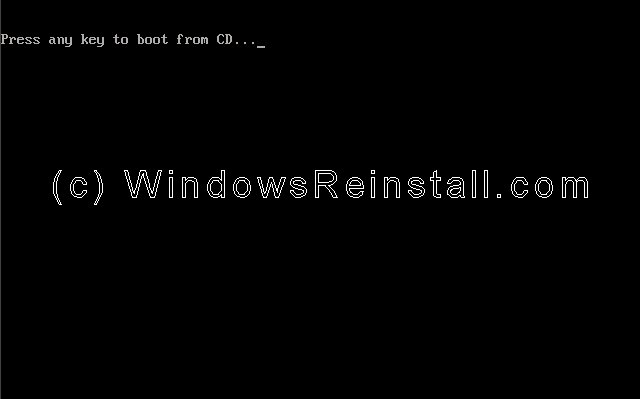
Windows will continue loading. 
Windows will now adjust your resolution, click "OK" to continue. 
If you are happy with the changes, click "OK" otherwise press "Cancel" to return to the old settings 
"Welcome to Microsoft Windows" screen now appears, press "Next" to continue. 
Internet connection option is next. If your computer connects to a Professional network or directly using the network card, or is on a network then select "Yes", otherwise select "No". 
Activate Windows option appears next, we recommend that you select "No, remind me every few days", that will allow you to make sure everything is correct and running OK before you use up one of your activate attempts. It also allows you to setup your security options and internet connection correctly. Click "Next to continue" 
Windows now thanks you, click "Finish" to continue. 
Finally setup the users for the computer, you must fill in option beside "Your name" the other four users are optional. Click "Next" once you have finished to continue. 
Windows will now apply your settings... 
Now Windows "WELCOME" screen. 
and finally the Windows XP Desktop. Windows is now installed. 
If you are lucky you will have no drivers to install, but chances are the next step will be to install them. Check out device manager for unknown devices, likely items are Network Cards, Sound Cards, Printers, Scanners, Graphics Cards, Digital Cameras, plus any other item you have. Also consider installing anti-virus software, spyware software and possibly a 3rd party Firewall.
| 